You are currently browsing the tag archive for the ‘history of detroit for young people’ tag.
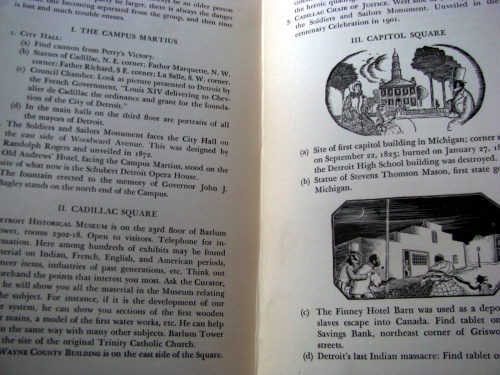
Construction continues on the new site, which should be up and running by the end of the week, although your friends aboard the Night Train aren’t making any promises.
One of the luxuries of writing about history, though, is that isn’t subject to the hyper-fast timeline that directs our daily lives. Taking a few days off the blog grind to learn code and play with my stylesheets puts a dent in my traffic stats, but I’m not worried about missing something on Twitter that won’t be relevant by the end of the day.
That isn’t to say that history doesn’t change. We revise it all the time; we change the stories we tell, how we tell them, the way the think about the characters involved. We build new monuments and memorials and tear down old ones. We fight about it. In Detroit, these fights are fever-pitch: the abandoned structures and empty lots that crowd the city are both monuments to a better past (one many Detroiters can personally remember) and painful memento mori of decline.
But there’s older, thicker history in the city that most of us forget after grade school. I like this mustier, more legendary stuff: the fur trade, the settlements, the berobed Jesuits and oak plank roads and war generals. I find it comforting. The past is tenacious, and we are strung to it.
So, scholarly asides aside: it was thus that we approached the tour itinerary provided in the 1933 edition of History of Detroit for Young People by Harriet and Florence Marsh. The original itinerary is bolded with our comments and photos below. Remember, watch for street car crossings and always have an older person with you.
I. THE CAMPUS MARTIUS
a. Find cannon from [Oliver Hazard] Perry’s victory.
No luck here. Does anyone know where this is? The Detroit Historical Society or the Dossin Great Lakes Museum, maybe? We saw some cannons on Washington Blvd., but they belonged to General Macomb, as it turned out.
b. Statues of Cadillac, N.E.corner; Father Marquette, N.W. corner; Father Richard, S.E. corner; La Salle, S.W. corner.

These are now on the campus of Wayne State University, in a park on Anthony Wayne Street. Father Richard’s aspect is especially haunting, and the Marshes speak lovingly of him, although they do mention that he was a plain, bespectacled man with a scar on his face from a sword wound. Not evident on the statue.
c. Council chamber. Look at picture presented to Detroit by French Government, “Louis XIV delivering to Chevalier de Cadillac the ordinance and grant for the foundation of the City of Detroit.”
Detroit City Hall was razed in 1961. I found this painting during a routine Google Book search, where it appeared on the cover of “Historical Collections” published by the Michigan Historical Society. The painting is credited as part of the “Art Musem of Detroit, 1902” — is it in the DIA now?
2. The Soldiers and Sailors Monument faces the City Hall on the east side of Woodward Avenue. This was designed by Randolph Rogers and unveiled in 1872.
 d
d
Standing triumphant.
3. Old Andrew’s Hotel, facing the Campus Martius, stood on the site of what now is the Schubert Detroit Opera House.
My dad speaks with a glint in his eye of Detroit’s movie house days, and he remembers the Schubert adoringly. The Schubert was demolished in 1964.
4. The fountain erected to the memory of Governor John J. Bagley stands on the north end of the campus.
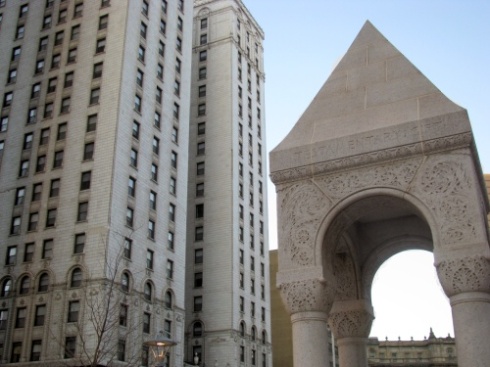
This odd, pyramidal marble structure still stands, although it’s pretty dry as fountains go. It’s got lions in the center. Rawr.
II. CADILLAC SQUARE
1. Detroit Historical Musem is on the 23rd floor of Barlum Tower, rooms 2302-18.
2. The Wayne County Building is on the east side of the square.
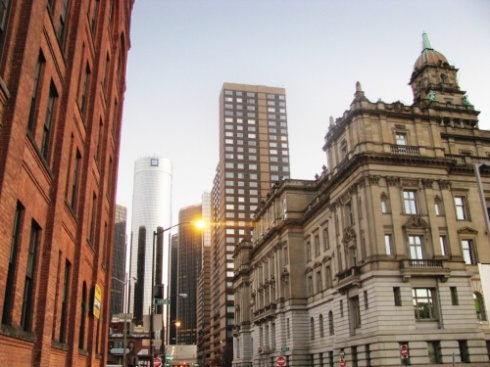
The Wayne County Building may be the finest standing example of Roman Baroque architecture in North America, says Wikipedia (I have to trust the crowds on this one as I know nothing about architecture and the claim is unsourced), and it’s one of my favorite buildings in the city. We tried to get in to nose around, but the security guard, though evidently delighted to see another human being in the building, regrettably informed us that it was closed, and advised us to call his boss, who has “a big heart for people like you.” (Tourists? History dorks? White kids running around downtown with cameras?)
Mad Anthony has rapidly become an obsession and my boyfriend has obligingly been ordering out-of-print biographies of him through interlibrary loan. The Erie, PA-based Erie Brewing Company makes a delicious American Pale Ale in Mad Anthony’s name and we recommend it.
3. Cadillac Chair of Justice
Buildings of Detroit eloquently describes the fate of the Chair of Justice: “By the late 1930s, the limestone had started to fall apart, and the chair had turned into a favorite resting spot for vagrants and drunks. On Nov. 1, 1941, workers showed up with sledgehammers and it was removed in pieces.”
VI. Points West of Woodward Ave.
We skipped around on this tour, mapless, downtown and on foot as we were.
a. Statue of General Alexander Macomb, born in Detroit and at one time Commander-in-Chief of the Army. It stands on Washington Boulevard at Michigan Avenue, opposite the Book-Cadillac.
Impressive! The glorious Macomb still stands handsomely on Washington Boulevard opposite the still-standing (and gloriously restored and open for business!) Book-Cadillac Hotel. Fun fact: Macomb’s statue is made out of melted down cannons.

Also on Washington Boulevard is a statue of Casimir Pulaski.
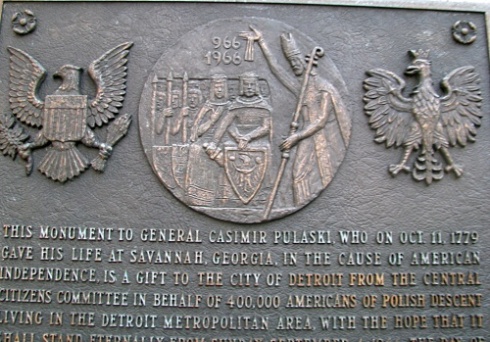
b. Mariner’s Church, northwest corner of Woodward Avenue and Woodbridge Street.
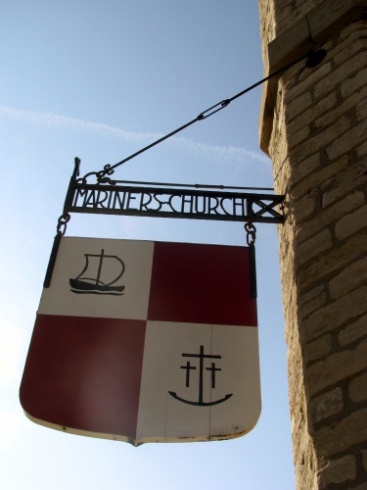
Old Mariner’s moved to Woodward and Jefferson in 1955.
h. Fort Shelby, originally Fort Lernoult, was located on what is now W. Fort Street from Griswold to Wayne streets. The Post Office is on this site.
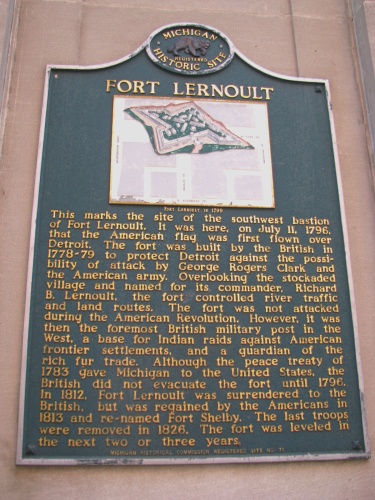
Not a Post Office anymore.
More to come!
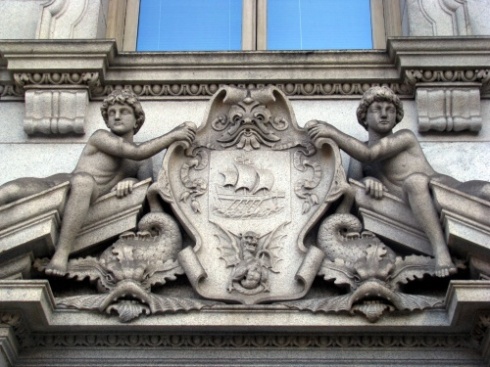
This weekend — with its unbelievable 60 degree weather, a healthy serving of historical adventuring and a rollicking season finale of Mad Men — was one of the best ever. The Hounds Below got down with their howly selves at the Majestic Cafe, we took in a month’s worth of accumulated recyclables, we witnessed the bowel-shaking power of the colossal pipe organ at Old Mariner’s Church and watched a 100-year-old retired sea captain ring one of the eight tolls of the bell to commemorate lives lost on the Great Lakes, and part one of our self-guided itinerary from History of Detroit for Young People (published in 1933) was a success.
I took lots of pictures and will share them soon, BUT: I must warn you that I am taking more decisive reigns at this blog and moving to a self-hosted server, which will give me more autonomy in the way the site looks and feels. BONUS: I am doing most of the technical work myself, and teaching myself how to do it, from building a custom header to exporting my existing database. So it may look a little wonky for a while.
I didn’t want to make this move until I had a solid sense of what I really thought I was doing, blogging here, but now that I’ve spent a month or so clearing up my voice and trusting my instincts and chasing what excites me, I think it’s become pretty clear. Thanks for slugging through the uncertainty.
This week: downtown and Campus Martius, then (from the treaty at Fort Lernoult to the razing of City Hall) and now (where is Oliver Hazard Perry’s cannon?); Farmington’s Pernambuco Hollow; more of the usual scratching around in old cemeteries.
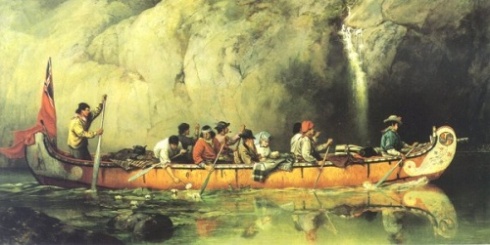
I love when people say Detroit is “a shadow of its former self,” or one of America’s “fallen cities.” The benchmark, of course, is Detroit at the height of its industrial success and the peak of its population in the 1950s. But I’ve been reading accounts of the city in the very earliest days of the fur trade and the French occupation, thinking to myself: will it ever be the same? I know what you’re thinking: grueling physical labor! the constant threat of Indian raids! no antibiotics OR contraceptives!
But I found this incredible book, History of Detroit for Young People, by Harriet and Florence Marsh, self-published in the early 1930s, and it makes the early settler days of southeastern Michigan sound pretty swell*:
I am forgetting the parties they had any time during the year that was convenient. The French, as a rule, have happy, cheerful dispositions. They work while they work, and play while they play. In spite of all the toil and hardship and real danger that these first settlers endured, both old and young were able to throw off care and anxiety and enjoy themselves whenever it was possible … [and] Every one, young and old, danced. … In those days, people really danced! Nobody sidled over the floor in our lazy fashion. These French people would never have wished to do so. If they had, they would not have dared, for their friends would have supposed they were ill, and ought to go home to bed.
Late in the 17th century, Cadillac wrote to the Comte de Frontenac that the chain of Great Lakes waters were “as richly set with islands as a queen’s necklace with jewels, and the beautifully verdant shores of the mainland served to complete the picture of a veritable paradise.” Of special interest to Cadillac was “the region that lies south of the pearl-like lake to which they gave the name of Ste. Clair, and the country bordering upon that deep, clear river, a quarter of a league broad, known as Le Detroit.”
After personally persuading Louis XIV to support a new post on the straits, Cadillac left France for Montreal and from there, on June 5, 1701, set sail with “one hundred Frenchmen and one hundred Algonquin.”
It was in the early summer, when we usually have beautiful weather. The twenty-five canoes were manned by stout voyageurs, who raced like mad over the water for two hours at a stretch, then stopped for a smoke and a rest. After this a new set of paddlers took the oars. The voyageurs had many jolly boating songs which they sang as they pulled the oars.
The Marshes include a few of these coureurs de bois folk songs in the appendix of the book, for kids at home to sing along (and for me to learn on my accordion?). They also tell charming stories that bring a playful vividness to life in the early settlement:
Cadillac brought three horses and ten head of oxen. Two of the horses died, but the fine one that was his saddle horse lived and must have been a great help to him in his journeys around the settlment … he named it Colon. Queer name for a horse, was it not? But horses get used to almost anything.
… If your father and mother had brought you to the settlement, who knows? Perhaps you might even have seen Cadillac some morning. If you had just arrived from France, even if you were a little boy, you would surely have been dressed in a little gown with long sleeves and a skirt that almost reached the floor. As you walked along, Cadillac might have come clattering by on Colon. And your mother, as she bowed to the Commandant, would have picked you up and squeezed herself into the nearest doorway. Ste. Anne Street was only twenty feet wide, and no one knows what a horse might do, especially if his name was Colon.
In an account of Detroit written for the King, Cadillac describes with most Baroque flourish the flora and fauna of the trading post, which has “never wept under the knife of the vine-dresser” or the “pitiless hand of the reaper.”
(from Detroit Perspectives: Crossroads and Turning Points, edited by Wilma Wood Hendrickson. Wayne State University Press, 1991):
Under these broad walks one sees assembled by hundreds the timid deer and faun, also the squirrel bounding in his eagerness to collect the apples and plums with which the earth is covered. Here the cautious turkey calls her numerous brood to gather the grapes, and here also their mates come to fill their large and gluttonous crops. Golden pheasants, the quail, the partridge, woodcock and numerous doves swarm in the woods and cover the country, which is dotted and broken with thickets and high forests of full-grown trees, forming a charming perspective, which sweetens the sad lonesomeness of the solitude. The hand of the pitiless reaper has never mown the luxurious grass upon which fatten woolly buffaloes, of magnificent size and proportion.
There are ten species of forest trees, among them are the walnut, white oak, red oak, the ash, the pine, white-wood and cotton-wood; straight as arrows, without knots, and almost without branches, except at the very top, and of prodigious size. Here the courageous eagle looks fiercely at the sun, with sufficient at his feet to satisfy his boldly armed claws. The fish are here nourished and bathed by living water of crystal clearness, and their great abundance renders them none the less delicious.
It sounds like a golden age to me.
(*There’ll be more gems from History of Detroit for Young People later this week, hopefully including a 2009 tour of one of the recommended itineraries in the appendix. A word of caution from the authors: “These trips are outlined with the hope that you may be able to get your father to drive you to these places. Because of the congestion of traffic in so many of the downtown districts, especially where changes of street cars must be made, it would not be safe for you to go with more than five or six companions. There should always be an older person with you.”)

